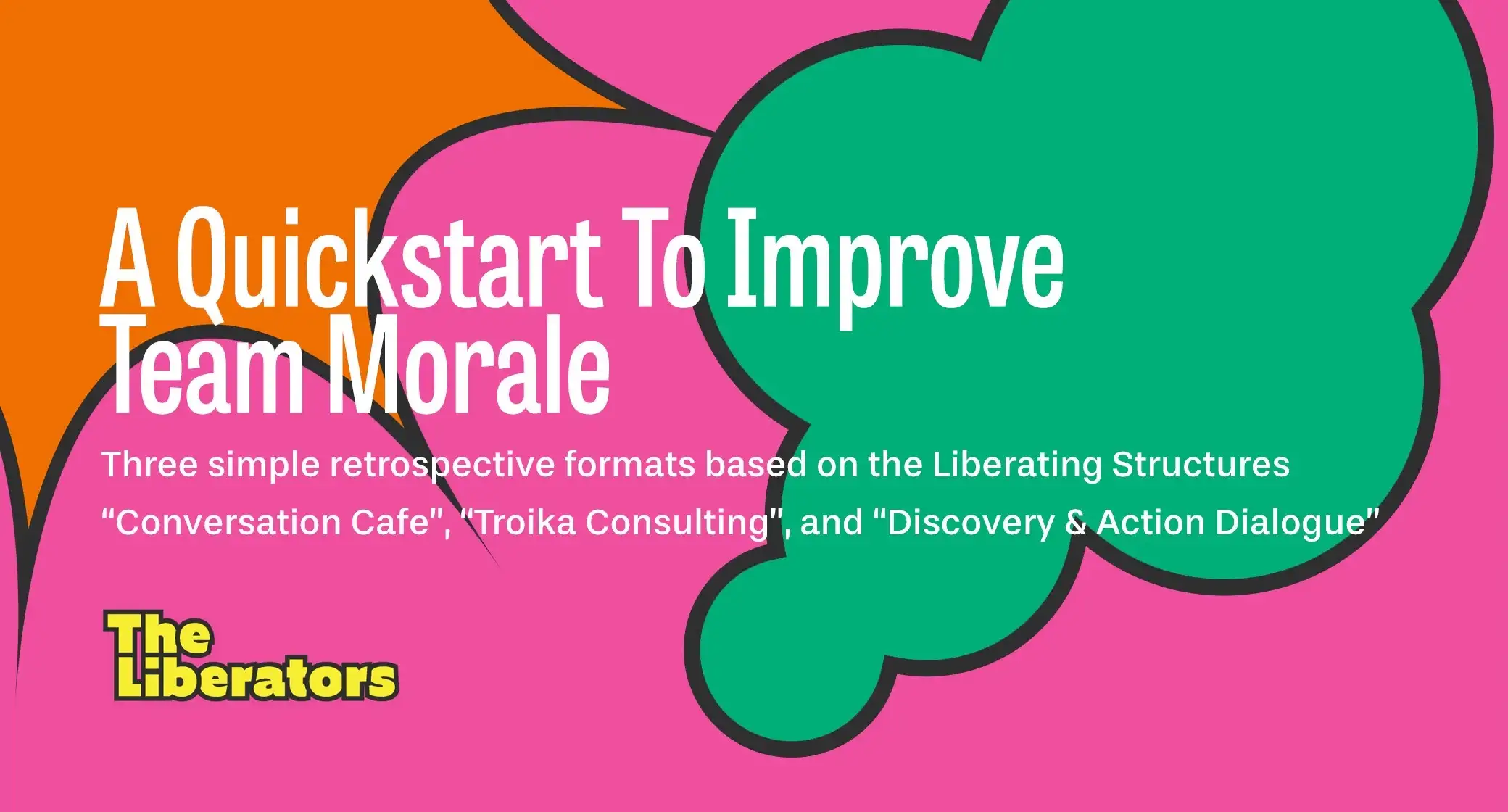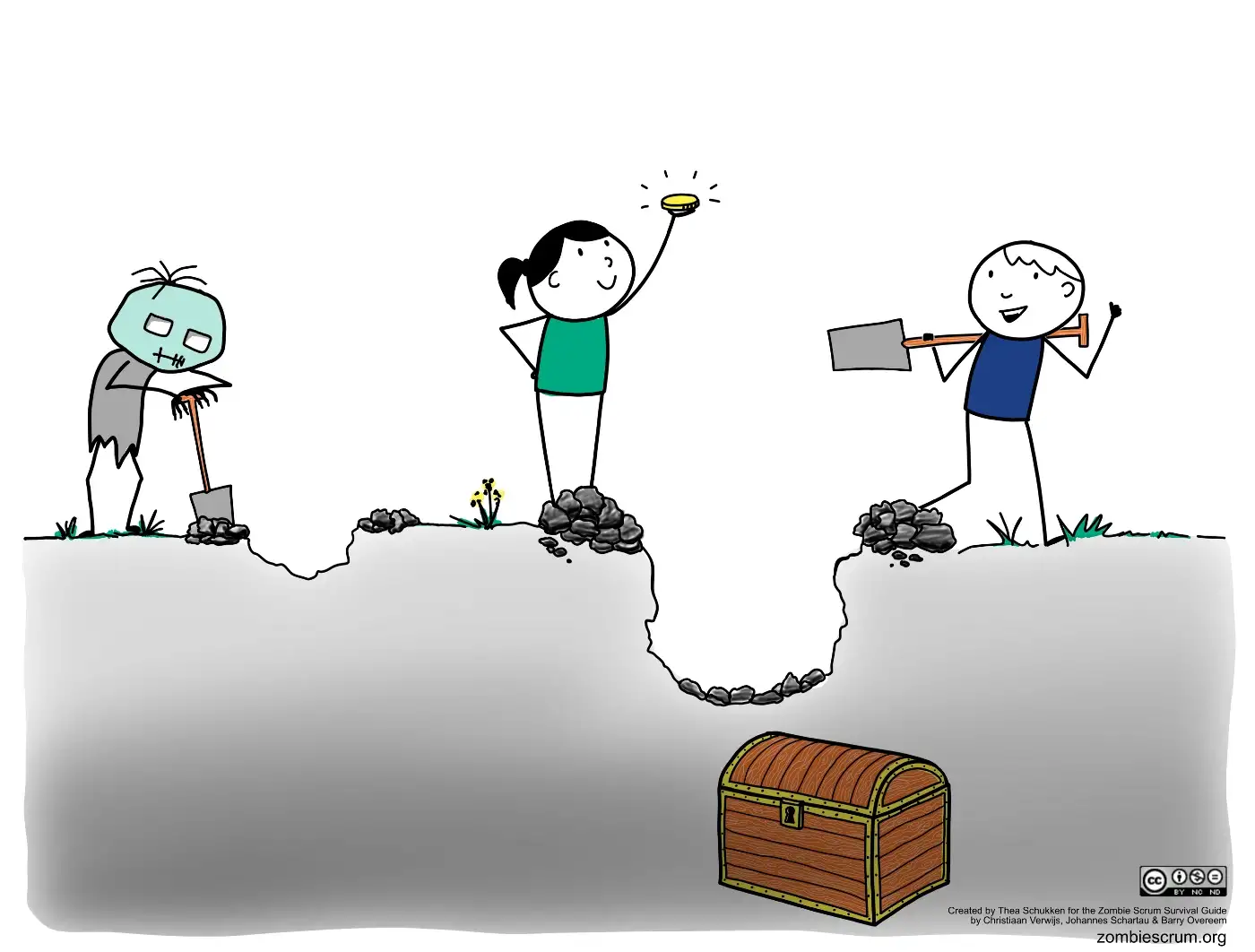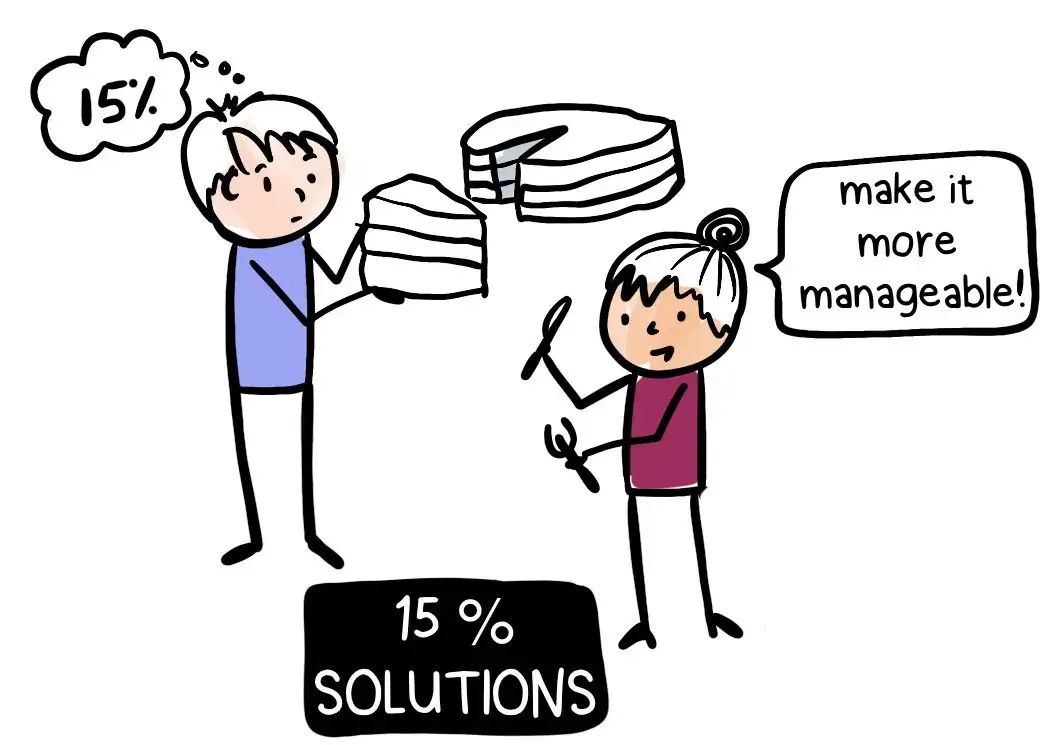
This article is also available as a free PDF on our webshop. It’s a nicely styled paper and allows you to easily share it with others. You can download the PDF here.
Team morale indicates how willing members are to push on in the face of difficulties. Teams with high morale find their work meaningful and feel motivated to work together. High morale is a buffer against inevitable setbacks and burnout, and a great indicator of the atmosphere in a team.
So what can you do when team morale is low? In this blog post, we share three short formats that easily fit inside a Sprint Retrospective. Their purpose is to start a dialogue in your team and begin improvement. The formats are based on the Liberating Structures “Conversation Cafe”, “Troika Consulting”, and “Discovery & Action Dialogue”. So pick the one that you think will work best and take it away!
We included many suggestions for small and actionable improvements that are useful when you feel stuck. If you’d like to dig deeper with your team, we also offer a selection of more extensive do-it-yourself workshops and additional resources to investigate team morale more fully.
Option 1: Conversation Cafe
Conversation Café encourages people to listen and understand each other’s perspectives on a profound, shared topic or challenge instead of trying to convince or persuade others to see it your way.
Sitting in a circle with a simple set of agreements and a talking object, small groups engage in consecutive rounds of dialogue. Conversation Cafe invites people to listen to one another’s thoughts and reflect together on a shared challenge.
Invitations for the 4 rounds
Round 1: “What have you noticed about morale in this team? What do we learn from the results? And what seems to be influencing our morale?”
Round 2: “What are new thoughts and feelings after having listened to everyone in the first round?”
Round 3: “So, what does this mean for our work together as a team, and the value we deliver to our stakeholders?”
Round 4: “Now, where do we go from here? Where do we have freedom and autonomy as a team to improve?”;

Steps
- Form groups of 5 people, sitting knee to knee. If you do this online, move people into breakout rooms for the entire Conversation Cafe. Debrief key takeaways of all the groups, once everyone is back in the main channel;
- (1 min) State the theme of the conversation. Ask people to write it down in their notebooks;
- (1 min) Provide a rough overview of the rounds. There will be four rounds of conversation, two first rounds using a talking object, the third one as an open conversation, and a final round with the talking object. Give the duration of each round;
- (2 min) Read the six Conversation Café agreements. See the text in the poster
- (1 min) Ask the groups to decide who becomes the “Host”. The host is a full participant whose role is to gently intervene only when a participant visibly fails to observe one of the six agreements, most frequently talking on and on. Also, make sure that each group selects a talking object (can be a pen or anything else in the vicinity);
- (1 min) Invite participants to reflect on the invitation;
- (5 min) Run the first round with the talking object: each person shares what he or she is thinking, feeling, or doing about the theme or topic. 1 min. per person
- (5 min) Second round with the talking object: each person shares thoughts and feelings after having listened to everybody at the table. 1 min. per person
- (20 min) Third round: open conversation (option to use talking object).
- (5 min) Fourth round with the talking object: each member shares “takeaways.”
Option 2: Troika Consulting
Troika Consulting is a powerful Liberating Structure that helps people gain insights into issues they face and unleash local wisdom for addressing them. In rapid rounds of “consultations”, individuals ask for help and get advice immediately from two others.

Invitation
“What would boost your morale in this team, but is difficult or challenging for you to do?”
Steps
- (1 min) Give everyone one minute of individual thinking to identify a personal challenge;
- (1 min) Invite participants to form groups of three and arrange chairs so that they sit knee-to-knee.
- Explain that Troika Consulting takes three rounds. Everyone will be a “Client” once, with the other two acting as “Consultants”;
- (3 min) Round one starts with the first client sharing his or her question in more detail. Consultants can ask the client clarifying questions;
- (5 min) Ask the client to turn around with their back facing the consultants. Talking only to each other, the consultants generate ideas, suggestions, and coaching advice. In the meantime, the client listens and takes notes;
- (2 min) The client turns back around and shares what was most valuable about the experience;
- Groups switch to the next person and repeat the steps.
Online Delivery
- Create sufficient breakout rooms for groups of three;
- Give an overview of the steps of Troika Consulting. Let people self-manage their timeboxes. Together, debrief what this was like;
Option 3: Discovery & Action Dialogue
As the name “Discovery & Action Dialogue” suggests, this structure takes the shape of structured dialogue. It helps groups carefully analyze the problem, potential solutions, and how everyone can contribute to both. It also builds helpful problem-solving skills in groups by providing them a useful structure to think about challenges in general.
Small groups answer the following questions:
1. “How do you know when morale in this team is low?”
2. “How do you contribute effectively to improving morale in this team?”
3. “What prevents you from doing this or taking these actions all the time?”
4. “Do you know anybody who is able to frequently solve this problem and overcome barriers? What behaviors or practices made their success possible?”
5. “Do you have any ideas?”
6. “What needs to be done to make it happen? Any volunteers?”
7. “Who else needs to be involved?”
Although there is a purposeful order to the questions, you can deviate from it if it makes more sense to you.

Discovery & Action Dialogue encourages teams to dig deep to find solutions to persistent problems.
Steps
- Create a shared space (on a wall, the floor, or virtually) where you can collect insights and answers from the various rounds.
- (5 min) Briefly introduce the problem the Scrum team will focus on. Divide the team into small groups with 3–5 participants and prepare the breakout rooms. Make sure everyone has a worksheet with the questions
- (2 min) Each group picks a “Guide” and a “Butterfly Catcher”. The Guide asks the questions while the Butterfly Catcher captures insights and quotes. Both the Guide and the Butterfly Catcher also answer the questions themselves, so they have an extra responsibility. The groups also decide on a talking object. Only the person holding it can speak and decide who goes next.
- (35 min) In their breakout rooms, the small groups answer the questions offered by the Guide. Make sure to always start with 1-minute of individual thinking and reflection. Only when the question is sufficiently addressed, the group moves on to the next question.
- (5 min) When all the questions are covered, the Butterfly Catcher recaps the outcomes and identifies the next steps.
- (10 min) When everyone is back in the main channel, ask the Butterfly Catchers to summarize the findings of each group.
3 Quick Tips To Improve Team Morale
The key to successful improvement is to take one small, actionable step at a time. Here are some ideas to inspire you:
- As a team, identify the #1 frustration of which everyone says “that’s just the way it works in this organization”. Work together to create a small step in the direction of challenging the status quo.
- Use the next Sprint Review to celebrate the success you’ve achieved as a team. If possible, invite your stakeholders too.
- During the next Sprint, work with your Product Owner to write the Product Goal on a large banner and put it visibly in the team room.

3 Do-It-Yourself Workshop To Dig Deeper
The do-it-yourself workshops allow Scrum teams to create transparency around the state of Scrum, offer a step-by-step explanation to inspect the results together, and give guidance to make adaptations accordingly.
3 DIY workshops to improve “Team Morale” are:
- Become Better At Helping Each Other With Helping Heuristics
- Improve How Your Scrum Team Uses Sprint Goals
- Clarify How To Deliver Value To Stakeholders With Purpose-to-Practice
3 Resources To Learn More
- Blog post: Don’t use happiness metrics, measure “Team Morale”
- Podcast episode: 10 Powerful Questions To Create Sprint Goals
- Blog post: In-Depth: Why Great Scrum Teams Have A Mind Of Their Own
Closing
In this article, we shared three simple 1-hour retrospective formats based on the Liberating Structures “Conversation Cafe”, “Troika Consulting”, and “Discovery & Action Dialogue”. We also included a bunch of small, actionable steps you can use for inspiration on how to improve, relevant do-it-yourself workshops to dig deeper, and additional resources to learn more.
If you’ve got any questions, comments, or ideas: always feel free to reach out and share them with us.
Let’s learn and grow, together!
